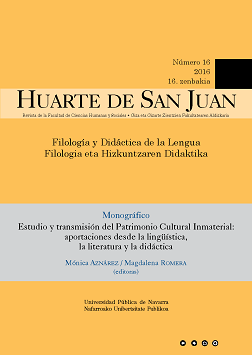Desarrollos didácticos del Archivo del Patrimonio Inmaterial de Navarra (APIN): un proyecto de Lengua castellana y Literatura en Secundaria
Keywords:
Project-based leaning, linguistic competence, cultural competence, digital competence, compulsory Secondary EducationAbstract
This work presents a didactic experience which was put into practice during a 3rd year Secondary Education Spanish Language and Literature course. It was based on the Digital Archive of the Immaterial Heritage of Navarra (APIN), whose educational potential in the different curricular areas is yet to be explored. The experience consisted in the implementation of a project entitled «Yesterday’s and Today’s pastimes », which included a final task of recording interviews about their free time activities to informants from different generations from a small town in Navarre. These recordings will eventually be included among the Spanish audio-visual testimonies of the APIN in one of its domains, the one related to the collective sociability practices. 25 students from a public secondary school participated in the project, during the academic year 2014-15; it was carried out in three phases and it included the following learning outcomes: development of the linguistic competence (the interview and the features of ethnolinguistic vitality), of the cultural competence (familiarization with the APIN) and of the digital competence.
Downloads
References
Archivo del patrimonio inmaterial de Navarra/Nafarroako ondare materiagabearen Artxiboa (APIN/NOMA) (s.d.): http://www.navarchivo.com/index.php/es (05/07/2016).
Aznárez, M. y A. Asiáin (2013): «Aplicaciones didácticas del patrimonio cultural inmaterial para la enseñanza de la competencia comunicativa», Lenguaje y Textos, 38, pp. 150-167.
Camps, A. (1996): «Proyectos de lengua: entre la teoría y la práctica», Cultura y Educación, 2, pp. 43-57.
Ciro Aristizábal, C. (2012): Aprendizaje por proyectos como estrategia de Enseñanza y Aprendizaje en la Educación General Básica y Media, tesis de máster, Universidad de Colombia. Recuperado de http://www.bdigital.unal.edu.co/9212/1/43253404.2013.pdf (18/07/2016).
Díaz Barriga, F. (2003): «Cognición situada y estrategias para el aprendizaje significativo», Revista Electrónica de Investigación Educativa, vol. 5, 2. Recuperado de https://redie.uabc.mx/redie/article/view/85/1396 (18/07/2016).
El País (s.d.): «Consejos periodísticos. La entrevista», El País de los estudiantes. Recuperado de http://www.estudiantes.elpais.com/descargas/consejo_entrevista.pdf (18/07/2016).
Eusko Jaurlaritza/Gobierno Vasco (s.d.): Las competencias básicas en el sistema educativo de la C.A.P.V. Recuperado de http://www.hezkuntza.ejgv.euskadi.eus/contenidos/informacion/dig_publicaciones_innovacion/es_curricul/adjuntos/14_curriculum_competencias_300/300002c_Pub_BN_Competencias_Basicas_c.pdf (16/07/2016).
Fernández, P. y M. A. Melero (comps.) (1995): La interacción social en contextos educativos, Madrid, Siglo XXI.
Galeana de la O, L. (2006): «Aprendizaje basado en proyectos», Investigación en educación a distancia. Recuperado de http://www.ceupromed.ucol.mx/revista/ (18/07/2016).
Gardner, H. (1999): Intelligence reframed: Multiple intelligences for XXI century, New York, Basics Books.
La Cueva, A. (1998): «La enseñanza por proyectos: ¿mito o reto?», Revista Iberoamericana de Educación, 16, pp. 165-187.
Ministerio de educación, cultura y deporte (s.d): El patrimonio cultural inmaterial. Recuperado de http://www.mecd.gob.es/redirigeme/ (18/07/2016).
OCDE (2005) La definición y la selección de las competencias clave. Recuperado de https://www.comclave.educarex.es/pluginfile.php/130/mod_resource/content/3/DESECO.pdf (18/07/2016).
Orden ECD/65/2015, de 21 de enero, Sec. I., pp. 6986-7003. Recuperado de https://www.boe.es/diario_boe/txt.php?id=BOE-A-2015-738 (18/07/2016).
Rychen, D. S. y L. H. Salganik (eds.), (2006): Las competencias clave para el bienestar personal, económico y social, Colección Aulae, 6, Archidona (Málaga), Aljibe.
UNESCO (s.d.): Los ámbitos del patrimonio cultural inmaterial. Recuperado de http://www.culturaydeporte.gob.es/cultura/areas/patrimonio/mc/patrimonio-inmaterial/unesco-patrimonio-inmaterial.html (18/07/2016).
Downloads
Published
How to Cite
Issue
Section
License
All articles are published under a Creative Commons (BY-NC-ND 4.0) license. Each article will be assigned a DOI.
Authors retain copyright of their work and grant the journal the right to the first publication. Authors can sign additional agreements to non-exclusive distribution of the published version of the article (for example, in an institutional repository) as long as appropriate attribution to the original publication is provided. Articles can be uploaded to institutional repositories immediately after publication.
Electronic distribution of the articles (for example, academic social networks or personal webpages) is allowed and encouraged.
The journal reserves the right to publicise the work in social networks and other electronic means.







